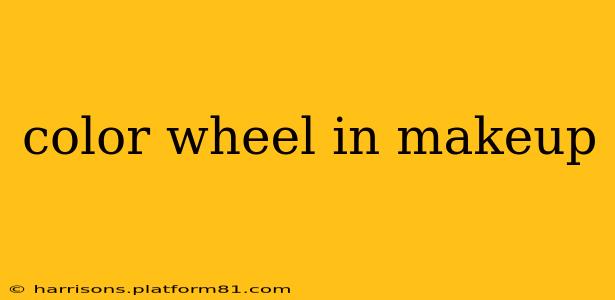The color wheel is a fundamental tool for artists of all kinds, and makeup artists are no exception. Understanding how colors interact—complementary, analogous, triadic—can elevate your makeup game from basic application to masterful artistry. This guide will break down the color wheel's principles and show you how to apply them to create stunning, harmonious, and balanced makeup looks.
What is the Color Wheel in Makeup?
The color wheel in makeup is a visual representation of colors arranged according to their relationships. It's based on the same principles as the color wheel used in art and design. Understanding these relationships – primary, secondary, tertiary colors, and their interactions – allows you to choose shades that complement your skin tone, enhance features, and create specific effects, such as a youthful glow or a dramatic smoky eye.
How Does the Color Wheel Work in Makeup?
The color wheel is built around three primary colors: red, yellow, and blue. These colors cannot be created by mixing other colors. Mixing two primary colors creates secondary colors:
- Red + Yellow = Orange
- Yellow + Blue = Green
- Blue + Red = Violet (Purple)
Mixing a primary color with a neighboring secondary color creates tertiary colors, such as red-orange, yellow-orange, yellow-green, blue-green, blue-violet, and red-violet. These nuanced shades offer a wide palette for subtle and sophisticated makeup looks.
Understanding Color Relationships on the Wheel:
-
Complementary Colors: These are colors opposite each other on the wheel (e.g., blue and orange, yellow and violet, red and green). They offer high contrast and can be used to create dramatic looks. For example, a blue eyeshadow paired with an orange blush can create a striking contrast. However, using complementary colors requires careful balance to avoid clashing.
-
Analogous Colors: These are colors that sit next to each other on the wheel (e.g., blue, blue-green, and green). They create harmonious and soothing looks. Using analogous colors in your makeup can produce a cohesive and naturally beautiful appearance.
-
Triadic Colors: These are three colors evenly spaced on the wheel (e.g., red, yellow, and blue; or orange, green, and violet). They offer a vibrant and balanced palette, creating visually interesting combinations. Triadic color schemes can be bold and expressive.
How to Use the Color Wheel to Choose Makeup Shades:
The color wheel is a powerful tool for selecting makeup that flatters your skin tone. For example:
-
Warm Skin Tones (yellow or golden undertones): Generally look best with warm colors like peaches, golds, corals, and bronzes. Avoid colors that are too cool or ashy.
-
Cool Skin Tones (pink or blue undertones): Generally look best with cool colors like pinks, purples, blues, and silvers. Avoid colors that are too orange or yellow.
-
Neutral Skin Tones (a mix of warm and cool undertones): Have the most versatility and can experiment with a wider range of colors.
What Colors Enhance Certain Features?
-
Eyes: Use complementary colors to make your eye color pop. For example, green eyes look stunning with shades of purple or plum, while brown eyes are enhanced by shades of green or copper.
-
Cheeks: Blushes in analogous colors to your lipstick can create a cohesive and natural look.
-
Lips: Consider your skin tone and outfit when choosing lipstick colors. Nude lipsticks can complement almost any look.
What are the Benefits of Using a Color Wheel for Makeup?
Using the color wheel for makeup offers several significant benefits:
- Harmonious Looks: Create balanced and visually pleasing makeup combinations.
- Enhanced Features: Accentuate your best features by using colors that complement your skin tone and eye color.
- Creative Exploration: Experiment with different color combinations and develop your own unique style.
- Professional Look: Achieve a polished and professional appearance.
How to Choose the Right Color Wheel for Makeup Application?
While digital color wheels are readily available online, a physical color wheel can be beneficial for hands-on visual learning. There are many options available, some specifically designed for makeup application. The key is to choose a wheel that allows you to easily identify complementary, analogous, and triadic color combinations.
Where Can I Learn More About Makeup and Color Theory?
Many online resources offer in-depth tutorials and courses on makeup application and color theory. You can also find valuable information in books and magazines dedicated to beauty and cosmetics. Practicing with different color combinations is key to mastering this art.
By understanding and applying the principles of the color wheel, you can transform your makeup routine from a simple application to a creative and expressive art form. Experiment, have fun, and enjoy the process of discovering your own unique style.
